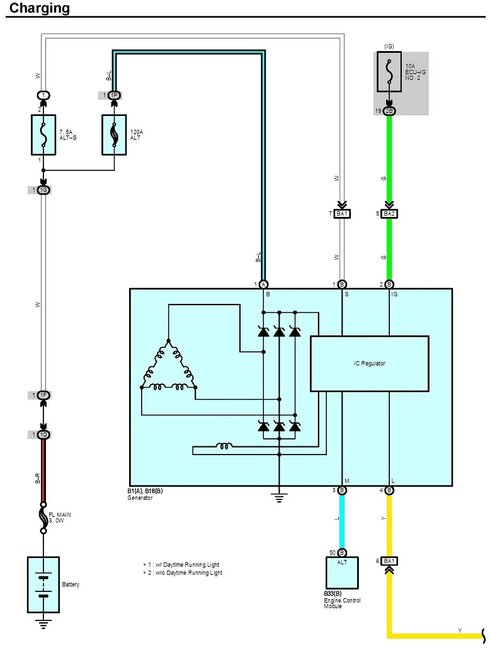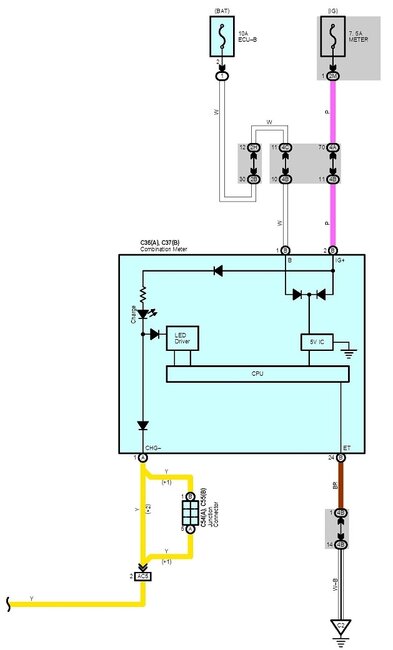I ignored going into more detail about diodes because you already replaced the generator, but that might not have been a good idea. The assumption is the diodes must be okay, but that might cause us to overlook something.
AC generators, ("alternator" is a Chrysler term), develop three-phase output which is very steady, smooth, and efficient. The alternating current is turned into direct current by the diodes so it can run the electrical system and be stored in the battery. When one diode fails, you lose one of those three phases. I put these drawings together to show what happens to ripple voltage. The top output waveform is normal. The difference from 14.0 to 14.5 volts is very small and easy for the battery to smooth out. That difference is the ripple voltage. In the lower waveform, one diode has failed and one phase is missing. Here the ripple voltage is 5.2 volts.
If you try to measure ripple voltage directly with a digital voltmeter, the best you can determine is whether you have very little or a lot. The first problem is digital meters take a reading, analyze it, then display the results while it analyzes the next reading. The value displayed will be bouncing around depending on the exact instant each reading is taken.
The other problem is on the "AC Volts" scale, the meters are designed to read a voltage that is changing polarity, specifically, at 60 hertz house voltage. While reading generator output, the polarity never changes. It's just the voltage that goes up and down while current keeps flowing in one direction. That isn't what AC voltmeters respond to. Also, they're designed around 60 hertz. Many better meters are also accurate up to 400 hertz for military use. The frequency of the three-phase output can be in the 1000s of hertz. There's over a dozen coils of wire in the stator, meaning there will be over a dozen cycles per one generator revolution. The crankshaft pulley is a lot larger in diameter than the generator's pulley, so when the engine is running at 1,000 rpm, the generator might be spinning at 5,000 rpm, times a dozen voltage pulses per revolution. Now we're way higher than any meter's frequency response. Professional load testers have circuitry specifically designed to read ripple voltage under these conditions, but even most of them do not give an exact voltage. There are a few that can make a paper printout that includes an exact ripple voltage, but after doing this for 40 years, I can't tell you what "normal" would be. Most testers just light up more or fewer bars on a relative bar chart to show if ripple voltage is "high" or "low".
My reason for discussing this has to do with how the voltage regulators respond to ripple voltage. First understand with one missing phase, the generator loses exactly two thirds of its output current capacity. The standard generator for your model is a 100-amp unit. With one bad diode, the most it will be able to deliver is close to 33 amps. That's not enough to run the entire electrical system with anything left over to keep the battery charged. The battery will have to make up the difference as it slowly runs down over days or weeks. That will be even worse if you do a lot of short-trip driving.
One of two things happens when ripple voltage is excessive. The first one is easy to follow. When voltage drops low, as in the 9.3 volts in the lower drawing, the voltage regulator responds by running the generator harder to try to get that voltage back up to where it should be. It does that by increasing the current flow through the rotating electromagnetic "field" coil. That makes a stronger electromagnet which induces a higher output voltage in the stator windings. Higher voltage, (pressure), means higher output current can be developed.
The maximum field current for any generator is close to three amps, but that also is a factor of the voltage behind it. In this story voltage drops momentarily to 9.3 volts. Think of the brightness of a flashlight when the batteries become run down. Current flow through the bulb goes down. Similarly, when system voltage drops to 9.3 volts, current through the field coil goes down too. That results in a weaker electromagnet, and lower output current. Now, to be fair, the battery is trying to hold system voltage up, but it only maintains up to 12.6 volts. Generators and electrical systems are designed to work properly at 13.75 to 14.75 volts. Even though system voltage is held up somewhat, it's still too low, and that low voltage is what's feeding the field coil, so its magnetic field is low, and generator output is low.
The other thing that can happen is the voltage regulator is successful at getting generator output voltage to go high enough, but it's working so hard, the high spots in that ripple voltage go too high, perhaps to 15 to 17 volts. The regulator responds by trying to reduce output, but usually not enough. This is where you would find charging voltage is within the acceptable range of 13.75 to 14.75 volts, yet the battery is always running down. That's why passing this charging voltage test, which is the only part you can do yourself, only means it is okay to continue on with the rest of the tests, which requires the professional load tester.
I know this is getting confusing. What I'm trying to get to is the 13.4 volts you've been coming up with is too low. If you equate this to the level in a municipal water tower, it's less than full. It can still supply water pressure to your house, but that pressure would be very low. My recommendation now is to have the rest of the charging system tests performed. The item of interest will be that ripple voltage, but the most telling value will be "full-load output current". That is going to come up close to 100 amps or 33 amps. The only way to get 100 amps is if all the diodes are okay. That will eliminate the generator as a suspect.
The clinker here is the voltage regulator is built into the generator, so a problem with it still ends up being a generator replacement. To further aggravate the issue, the Engine Computer gets involved to modify charging voltage under certain conditions, so that adds another variable and another potential source of low charging system voltage.
After all this, also look for a loose generator drive belt. It can slip if a spring-loaded tensioner pulley is rusted tight and not pulling the belt tight. That doesn't always result in a belt squeal.
Let me know what you find up to this point, then I'll try to figure out where to go next.
Images (Click to make bigger)
Tuesday, December 20th, 2022 AT 12:53 PM





